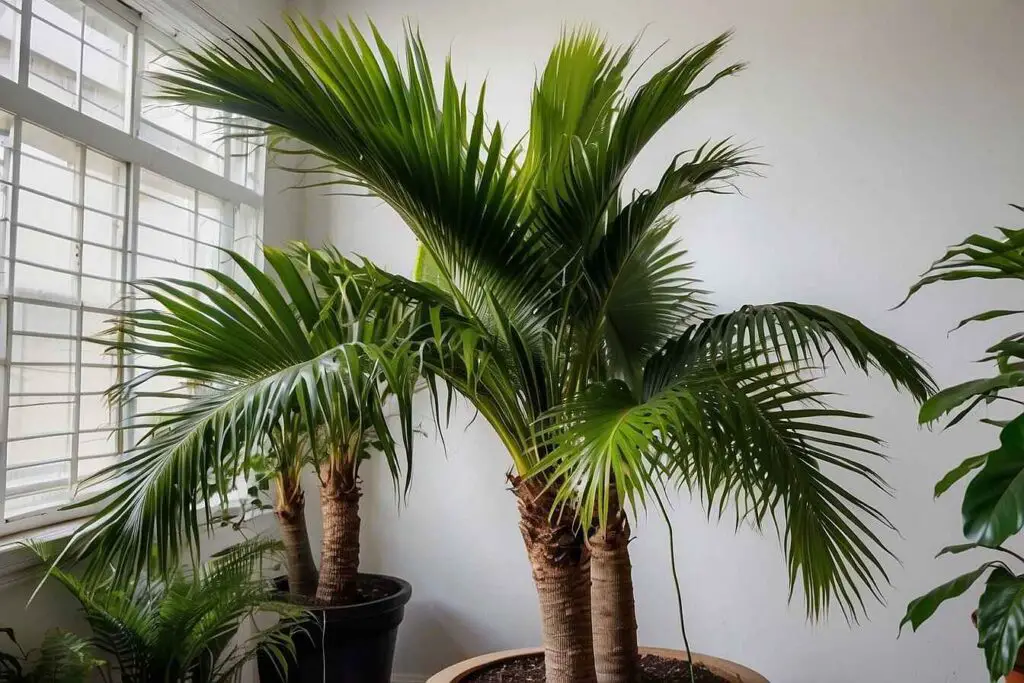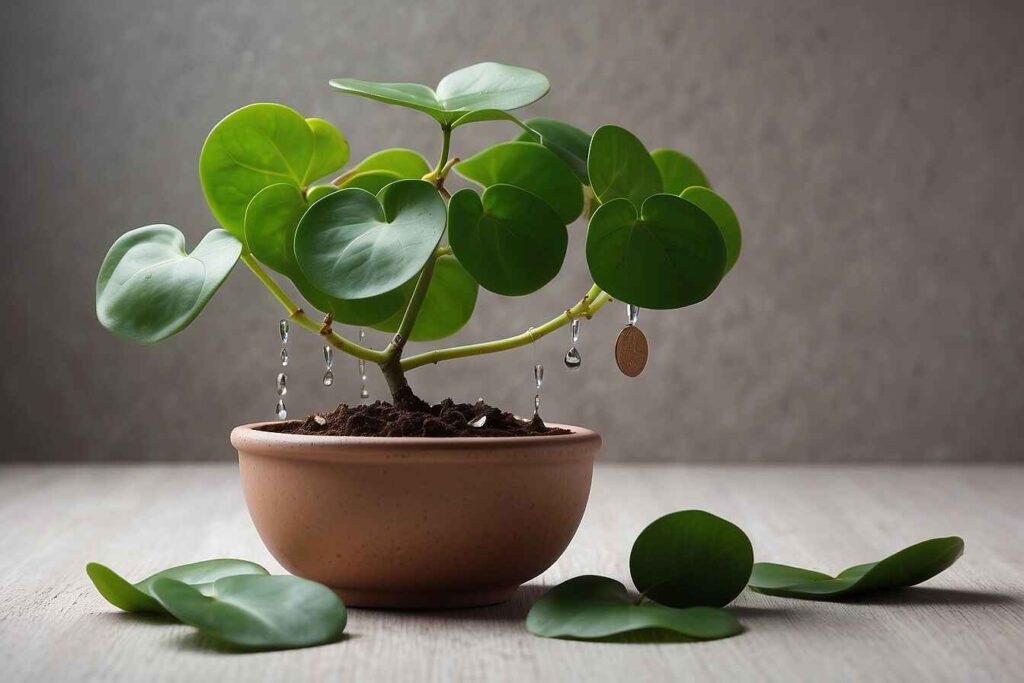Ravenea rivularis, known as Majesty Palm, is a striking Arecaceae palm. It has regal, tropical appeal with slender, feather-like fronds. The palm exudes sophistication, enhancing indoor spaces.
Originating from Madagascar’s lush lands, the Majesty Palm loves warm, humid climates. It belongs to the Arecaceae family, known for diverse palm species. This palm is unique and can adapt well indoors.
The Majesty Palm has a lovely shape and beautiful leaves. Many indoor gardeners like it for adding natural beauty to their homes. It’s easy to care for and can survive in low light, making it great for busy people or those new to gardening. This plant lets you enjoy tropical greenery even in dimly lit areas.
To improve your indoor oasis, it’s important to know how to propagate majesty palm. To ensure you always have plenty of this beautiful plant in your home, learn how to grow more. You can do this by splitting it or by growing it from seeds.
Exploring Propagation Methods: How to Propagate Majesty Palm
Delve into Majesty Palms; propagating them is rewarding and crucial for greenery expansion. In this part, we’ll look at why growing Majesty Palms is vital and the different ways to do it successfully.
Importance of Propagating Majesty

Majesty Palms have graceful fronds and look elegant. They are great for indoor spaces like homes, offices, or public areas. By learning how to propagate Majesty Palm, people increase greenery inside and feel closer to nature. Growing these palms helps save their beauty and diverse features for the future.
Division and Seed Germination
- Majesty Palms are mainly spread using two methods: splitting and growing from seeds.
- To create new plants, you can separate and replant offshoots or “pups” from the parent plant.
- You can propagate Majesty Palm by collecting and sprouting seeds, initiating the growth cycle as part of the How to Propagate Majesty Palm procedure.
Benefits and Challenges Associated with Each Method
- Division is a fast way to grow plants. It works better than using seeds.
- Division is a great way for growers. They can make exact copies of a plant, keeping it consistent in how it looks and grows.
- Sometimes, splitting a plant isn’t possible. This could happen if the main plant doesn’t make new growth or if growers want to make many plants at once.
- Seed germination takes time and can be unpredictable. It can create a variety of new plants, each with different traits.
- Seed germination needs the right environment. It can make plants grow at different rates and have various traits.
Propagation by Division
Propagating Majesty Palms through division is effective. It helps expand indoor greenery. By learning how to propagate Majesty Palm through division, enthusiasts can preserve parent plant characteristics. In this part, we will explain how to grow Majesty Palms by dividing them. We’ll use key terms like “grow palm from cutting” for clarity.
1. Equipment and Preparation
- Gather necessary equipment like tools, hormone, soil, and pots for planting. Before starting, items must be sterilized and well-sharpened.
- Make sure your workspace is tidy and big to easily handle the division work.
2. Identifying the Parent Plant
- Start by choosing a grown Majesty Palm plant that looks healthy and has some “pups” you can separate.
- Search for new plants growing from the bottom of the main plant or on the trunk. These are perfect for making new plants.
3. Preparing the Palm for Division
- Water the parent plant thoroughly a few days before initiating the division process. Water the parent plant well a few days before splitting it. Wet soil helps take the palm out of its pot without harming the roots.
- Using clean tools, cut off any dead or damaged parts from the parent plant to help it grow strong and healthy.
4. Removing the Palm from its Pot
- Gently tap or squeeze the sides of the pot to loosen the soil and root ball.
- Carefully lift the Majesty Palm from its pot. Support the base of the plant to avoid root damage.
5. Separating the Offshoots
- Examine the parent plant’s root ball. Identify the smaller branches connected to the main root system.
- Untangle the roots of the baby plants from the main plant. Make sure each baby plant has enough roots connected to it.
- Cut the small plants from the main one using sharp tools to avoid hurting the roots.
6. Potting the Offshoots
- If using rooting hormone, apply it to the cut ends of the offshoots to promote root development.
- Plant the new plant pieces in pots with good soil. Cover the roots about two inches deep.
- Water the newly potted offshoots completely. Put them in a spot with indirect sunlight to help roots grow.
7. Best Practices and Timing
- Divide Majesty Palms in late spring or early summer. This helps increase success when splitting them during the growing season.
- Regularly check the new plants you potted for growth signs. Adjust watering as required to keep the soil damp.
Seed Propagation: How to Propagate Majesty Palm for Indoor Greenery
Embark on learning how to propagating Majesty Palms from seeds for a rewarding experience. Enthusiasts find it fascinating. Explore seed propagation techniques. Include “propagating majesty palm from seeds” for a comprehensive guide.
1. Seed Collection and Preparation
Begin by collecting fully ripe Majesty Palm seeds from mature fruits. Ripe seeds are usually dark brown and have hard shells. After collecting them, take off the outer layer to reveal the hard seed coat underneath.
2. Scarification and Pre-treatment
To help seeds grow better, scratch the tough seed coat with sandpaper or a knife. Gently rub the seed’s surface to make tiny scratches. This helps water absorb better and seeds grow faster. After scratching, soak the seeds in water with hormones for seven days. Regularly change the water to prevent stagnation and maintain freshness.
3. Planting the Seeds
Prepare a well-draining soil mixture suitable for seed germination. Ensure the soil stays damp but not soaked to avoid seed decay. Plant the treated Majesty Palm seeds about half an inch deep in the soil. Put the seed tray in a sunny spot with indirect light for best growth conditions.
4. Providing Ideal Environmental Conditions
- Keep the soil damp when seeds are sprouting by watering them often. Avoid over-watering, as this can lead to fungal diseases and seedling damping-off.
- Cover the seed tray with a clear plastic bag. This makes a small greenhouse, keeping things warm and damp to help the seeds sprout.
- Closely watch the seeds for sprouting, which usually happens in three to six months. When the seeds start growing, take off the plastic and keep them moist and in the sun for the seedlings to grow.
5. Nurturing the Seedlings
- As the seedlings grow, move them to separate pots with good drainage soil.
- Ensure seedlings get enough sunlight and water to grow well.
- Gradually acclimate the seedlings to their new environment. Expose them to more sunlight over time.
6. Cultivating Majesty Palms from Seeds:

- Cultivating Majesty Palms from seeds is an exciting journey. Each seedling has the potential to become a beautiful plant.
- Be patient and take care when growing your Majesty Palms from seeds. Celebrate each milestone as they grow and thrive.
Majesty Palm Care Post-Propagation
After growing Majesty Palms, it’s crucial to give them the best care to keep them healthy and strong. In this part, we will explore how to propagate Majesty Palms and provide important care tips for helping newly grown plants thrive. We will focus on words like “majesty palm indoor” and “majesty palm outdoor” to help them grow well.
1. Light Requirements
After growing Majesty Palms, it’s crucial to give them the best care to keep them healthy and strong. In this part, we will look at important care tips for helping newly grown Majesty Palms. We will focus on words like “majesty palm indoor” and “majesty palm outdoor” to help them grow well.
2. Watering Techniques
Develop a watering plan by checking soil moisture levels. Water deeply when the top layer of soil is dry. Avoid giving too much water to your Majesty Palm as it can cause root rot and other problems. Keep an eye on the leaves for signs of watering needs. Brown tips may indicate dryness, while yellowing leaves can signal excessive moisture.
3. Temperature and Humidity Control:
Majesty Palms prefer temperatures ranging from 65-85°F (18-29°C). Maintain a consistent temperature within this range to support optimal growth.In dry areas, add moisture to the air with a humidifier or by spraying water on the plant’s leaves. Indoor Majesty Palms need a humid environment because dry air can harm them.
4. Soil Preferences and Fertilization Strategies
Plant Majesty Palms in soil that drains well and is slightly acidic with a pH around 5.0. Ensure the soil provides adequate aeration and drainage to prevent waterlogging.After two months, use a slow-release palm fertilizer for your Majesty Palms. Apply fertilizer every 2-3 months in the growing season for plant health.Choose fertilizers made for palms with a 3-1-3 NPK ratio. This mix prevents nutrient problems and boosts leaf growth.
5. Potential Issues Post-Propagation
Monitor newly propagated Majesty Palms for potential issues such as pests and diseases. Check the plant often for bugs or sickness. Fix any problems right away.Watch out for transplant shock. It can make new plants look droopy or grow slowly. Provide consistent care and patience as the plant adjusts to its new environment.
Troubleshooting and Solutions
Majesty Palms may face common issues despite careful propagation and care. Attention required. In this part, we’ll explore how to propagate Majesty Palms and address these problems with effective solutions. We’ll also cover terms like “growing majesty palms” and “majesty palm pests.” .
1. Pests and Diseases
Regularly check Majesty Palms for bugs like spider mites, aphids, or mealybugs. Search for signs such as yellow leaves, sticky residue, or bugs on the plant. If you find pests, keep the plant separate to stop them from spreading. Treat the Majesty Palm gently with insecticidal soap or neem oil spray. Follow the product instructions carefully. Repeat the treatment until the bugs are gone. Before propagating Majesty Palms, check the old plant for bugs or diseases. Quarantine new plants before introducing them to your collection to prevent contamination.
2. Transplant Shock
When Majesty Palms are moved to new pots or places, they might get transplant shock. Symptoms may show as wilting leaves, drooping foliage, or slowed growth. To ease transplant shock, keep care and conditions steady for the plant’s recovery. Ensure adequate watering and proper light exposure, and avoid disturbing the roots unnecessarily. Given time and patience, the Majesty Palm will recover and grow well again. To avoid transplant shock, handle the plant carefully during propagation and transplanting. Select the right pot size and soil type. Avoid giving too much or too little water during the adjustment time.
For more articles relating to weeds, here’s a link to How to Propagate Rhododendron that you may enjoy.
Frequently Asked Questions
Can I grow Chinese money plant and Majesty Palm indoors ?
Yes, both the Chinese money plant and Majesty Palm can be grown indoors successfully with proper care.


good realy appreciate it
i WANT TO AFFILIATE WORK WITH YOU PLEASE CONTACT ON ME
great dude! very helpful blog